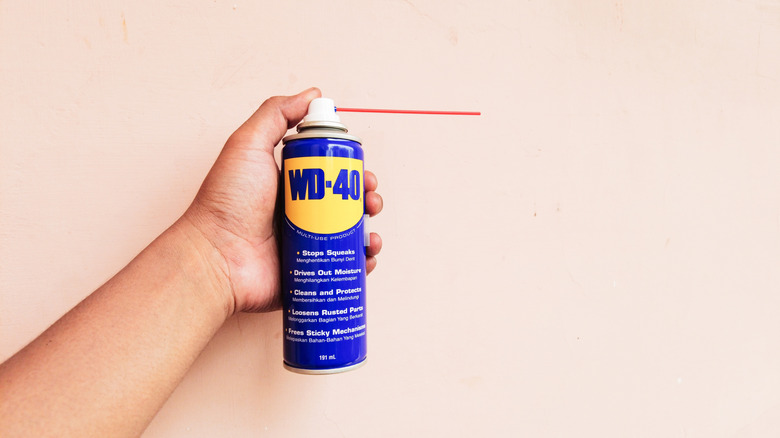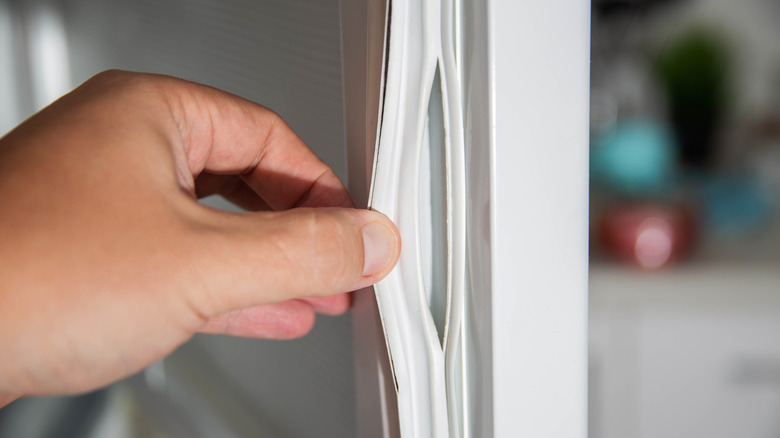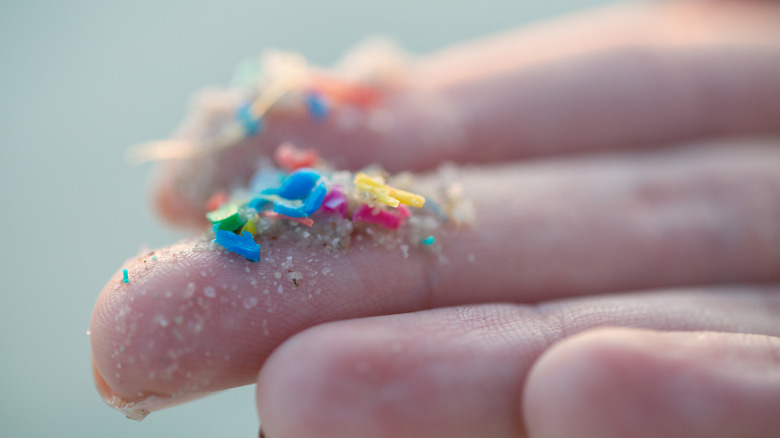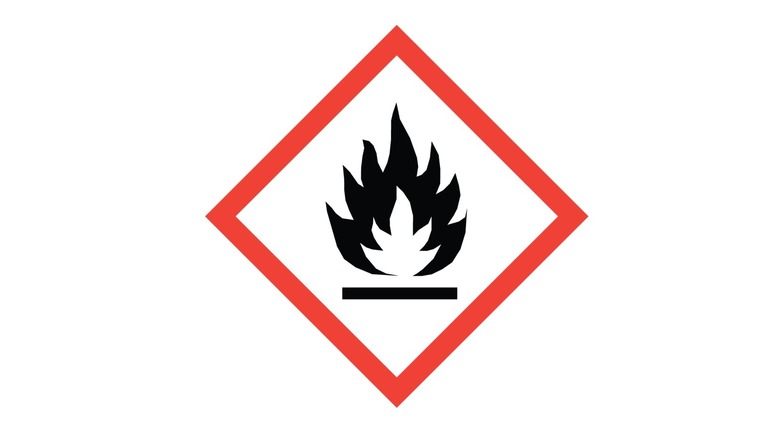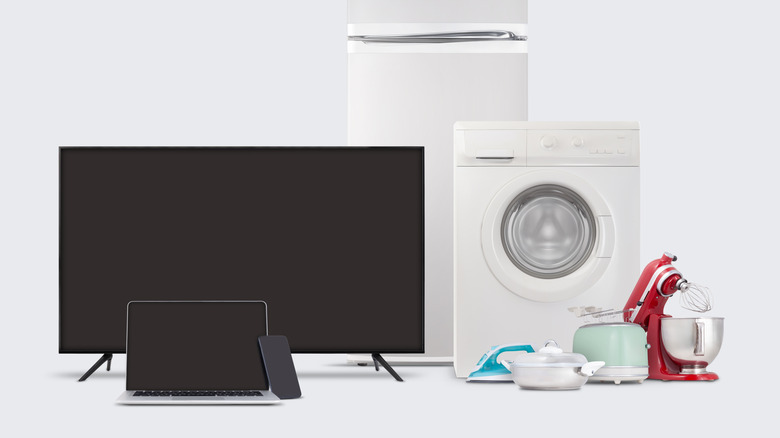5 Things WD-40 Should Never Be Used On
WD-40 is a seemingly all-purpose lubricant, degreaser, and water displacer that has helped people loosen stubborn bolts and silence squeaking hinges for decades. There's an old saying that if you need something stuck, you use duct tape, and if you need something unstuck, you use WD-40. Its versatility has made it a practical necessity in workshops everywhere, but that doesn't mean it's the right tool for every job.
Short for "water displacement, 40th formula," the precise components of WD-40 are unknown. The formula was never patented, and it remains a trade secret to this day. While WD-40 is great for getting things to move more easily and more quietly, sometimes it's better to reach for something else.
Because WD-40 is an all-purpose product, it's pretty good at a lot of jobs but not necessarily the best at any particular job. It's worth noting that this discussion refers specifically to regular WD-40. The company does offer alternative versions formulated for use in more specialized circumstances. Sometimes using WD-40 is perfectly fine, sometimes it can work as a temporary fix in a pinch, and other times it's a seriously bad idea. Here are five times you should put the WD-40 down and reach for an alternative.
Avoid using WD-40 on rubber
A squeaky door hinge is the classic use case for WD-40, but you might want to pause for a moment before you pop open a fresh can. Many doors, especially exterior doors, are lined with rubber weather stripping to keep wind and water outside. Those rubber components can be negatively affected by exposure to WD-40, eventually causing them to break down and fail.
While the exact recipe for WD-40 is a mystery, we do know it contains solvents that can cause rubber to soften and swell. It's probably fine to spray occasionally; it's not as if your seals are going to fall apart after a single spray. Over time, however, WD-40 strips oils out of rubber, making it brittle. While some synthetic rubbers hold up against WD-40 better than other types of rubber, it's best to avoid anything containing rubber when possible.
You might get rid of the squeaking only to introduce a much bigger problem when wind or rain starts leaking in through your door frames. Interior doors like those on bathrooms or bedrooms might benefit from a little WD-40 every once in a while, but you should probably skip it on your exterior doors and windows.
WD-40 can damage plastic parts
WD-40 has a reputation for being useful for just about any material and situation, but it shouldn't be used on plastic. If your squeaky window tracks or door slides are made of plastic, just as a couple of examples, WD-40 may not be the best option.
Plastics are petroleum-based products, and WD-40's effects are a matter of chemistry. When you spray WD-40 on metal, it displaces water and oil, allowing parts to move more smoothly. When you spray it on plastics, it reacts with molecules in the polymers, causing them to break down.
You probably won't notice any problems right away, but extended exposure will cause plastics to soften and crack over time, potentially causing crucial parts to break down. Some plastics, like the polyethylene used in hard plastic products, are more resistant to breaking down, but the best rule of thumb is to avoid using WD-40 on any plastic parts.
Keep WD-40 away from heat sources
Considering that WD-40 is made of petroleum, hydrocarbons, and propellant, all mixed together and pressurized inside an aerosol can, the mixture is highly flammable and susceptible to heat exposure. Hanging out around heat is one of the biggest mistakes you can make when using WD-40.
Product safety information lists the product as extremely flammable when in use and notes a risk of explosion if the can is exposed to heat. Keep WD-40 away from heat sources, hot surfaces, open flames, sparks, and any other potential ignition source. That means candles, space heaters, hot plates, candle warmers, and cigarettes. Protect the can from direct sunlight and store it in a cool, dark, well-ventilated area where temperatures don't exceed 122 degrees Fahrenheit.
It's important to avoid heat or flames before or after using WD-40. Residue can hang around for a while, and the vapors are heavier than air, allowing them to settle and even flow to the lowest point in a room. Never use WD-40 on or around any gas appliance, including stoves, clothes dryers, and water heaters. Even if your major appliances aren't fed by gas, any heat source can lead to a fire. So, while WD-40 might stop your dryer from squeaking, it might also burn your house down.
Never use ordinary WD-40 on electronics
If you've got corroded electrical components or dust and grime caked into the nooks and crannies of your favorite gadgets, you might be tempted to reach for a can of WD-40. While it's great for loosening stuck materials, the all-purpose product isn't formulated for use with electronics.
If you spray ordinary WD-40 on your electrical components, it may leave a conductive residue behind, potentially leading to harmful shorts or fires. Even if that doesn't happen, WD-40 residue can attract dust and grime down the line, giving it a nice and oily surface to stick to. It could clear up dirt and dust in the short term only to gum up your electronics later.
Instead, if you need to loosen up, clean, or lubricate your electronics, opt for something specifically designed for use with those materials. The WD-40 company produces a line of specialty products, including a can of contact cleaner formulated for use with electronics. It gets in there, loosens up corrosion and other debris, then evaporates almost immediately, leaving no residue behind. It's worth noting that WD-40 contact cleaner is still flammable, so avoid using it on any hot electronics.
Keep WD-40 away from your locks
Over time, key-operated locks can get stiff and become difficult to turn. In some cases, you might struggle to get your key into the lock or struggle to remove it after unlocking the door. With a fiddly front door, you might be tempted to reach for a can of WD-40, but you'd be asking for trouble.
A quick spritz of WD-40 may alleviate a stiff lock temporarily, but there's not enough grease in the all-purpose aerosol to properly lubricate the lock mechanism long-term. In fact, the degreaser in WD-40 can actually remove what little grease remains in your lock, making the lock stick even more.
Perhaps worst of all, residue from WD-40 can attract dust and grime, gumming up the mechanism until it stops working entirely. Instead, use a dedicated lock lubricant like graphite powder. In a pinch, you can make your own graphite powder with a pencil. Just trace over the grooves of your key until the pencil graphite is applied, then insert the key into the lock. Repeat until your lock is properly loosened up.
